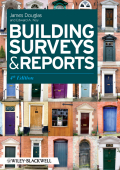
INDICE: Preface to Fourth Edition. Acknowledgements. 1 General Principles and Responsibilities. 1.1 What is a building survey. 1.2 Housing quality initiatives. 1.3 Other housing quality initiatives. 1.4 Housing health and safety rating system (HHSRS). 1.5 Domestic survey implications. 1.6 Non-domestic condition rating system. 1.7 Condition appraisal. 1.8 The purpose of the survey. 1.9Surveyor's responsibilities. 1.10 Contracts and fees. 2 Procedure and Equipment. 2.1 Basic survey methodology. 2.2 Preliminary operations. 2.3 Property risks. 2.4 Equipment for measured drawing surveys. 2.5 Equipment for surveying buildings and examining defects. 3 Measurement of Existing Buildings. 3.1 Preliminaries. 3.2 Internal measuring. 3.3 Roof space. 3.4 External measuring. 3.5 Levelling. 3.6 Plotting the survey. 4 Surveys of Historic Buildings. 4.1 General considerations. 4.2 Medieval churches. 4.3 Church towers. 4.4 Church bells and fittings. 4.5 Measured drawings. 5 Foundation Failures. 5.1 Introduction. 5.2 Causes of failure. 5.3 Differential movement. 5.4 Inadequate foundations. 5.5 Overloading. 5.6 Unequal settlement. 5.7 Effect of tree roots. 5.8 Shallow foundations. 5.9 Building on sloping sites. 5.10 Building on made up ground. 5.11 Diagnosis. 6 Defective Walls and Partitions Above Ground. 6.1 Type of failure. 6.2 Bulging and leaning walls. 6.3 Overloading. 6.4 Thermal and moisture movements. 6.5 Failure in arches and lintels. 6.6 Defective materials and chemical action. 6.7 Failures in bonding and defects at junctions. 6.8 Frost failure. 6.9 Cavity walls. 6.10 Built-in iron and steel members. 6.11 Tile and slate hanging and weatherboarding. 6.12 Partitions. 6.13 Assessment of cracks. 6.14 Natural stone masonry. 6.15 Defects in stonework. 6.16 Cast stone. 6.17 Recording defects. 7 Reinforced Concrete, Cladding Materials and Structural Steelwork. 7.1 Description. 7.2 Corrosion and cracking. 7.3 Aggregates. 7.4 High alumina cement. 7.5 Thermal expansion. 7.6 Frost damage. 7.7 Electrolytic action.7.8 Lightweight aggregates. 7.9 Deflection. 7.10 Diagnosis. 7.11 Brick panel walls in reinforced concrete frames. 7.12 No-fines concrete housing. 7.13 Autoclaved aerated concrete. 7.14 Description. 7.15 Concrete cladding defects. 7.16 Joint problems. 7.17 Metallic fasteners. 7.18 Metal profile sheeting. 7.19 Description. 7.20 Diagnosis. 8 Damp Penetration and Condensation. 8.1 Description. 8.2 Damp courses. 8.3 Diagnosis. 8.4 Solid walls with DPC absent or defective. 8.5 Stone walls in older buildings. 8.6 Basement walls and floors. 8.7 Heaped earth or paving against walls and bridging of rendering. 8.8 Internal partitions. 8.9 Rising damp in ground floors. 8.10 Rising damp in old timber-framed buildings. 8.11 Locating damp penetration. 8.12 Parapet walls. 8.13 Cavity walls. 8.
- ISBN: 978-1-4051-9761-8
- Editorial: Wiley-Blackwell
- Encuadernacion: Rústica
- Páginas: 432
- Fecha Publicación: 31/12/2010
- Nº Volúmenes: 1
- Idioma: Inglés
